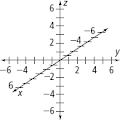Three-Dimensional Rotations
|

and z, as shown at the right. There are three intersecting planes,
each of which is referred to by the two axes that it contains:
the xy plane, the xz plane, and the yz plane. Each point in the
system has coordinates in the form (x, y, z).
In two dimensions, rotations are movements around a
fixed
point in a plane. A triangle rotated about the origin in two
dimensions could have been “moved” just as easily by leaving
the triangle as is and rotating the x- and y-axes. In fact, in three
dimensions this is exactly how rotations are accomplished. The axes
are rotated, and the geometric figure is mapped to a new location.
point in a plane. A triangle rotated about the origin in two
dimensions could have been “moved” just as easily by leaving
the triangle as is and rotating the x- and y-axes. In fact, in three
dimensions this is exactly how rotations are accomplished. The axes
are rotated, and the geometric figure is mapped to a new location.
For example, the
rectangular solid below has vertices at A(–2, 0, 3), B(–2, 2, 3),
C(–2, 2, 0), D(–2, 0, 0), E(–6, 0, 0), F(–6, 0, 3), G(–6, 2, 3), and H(–6, 2, 0).
The second figure shows the solid mapped to a new position by a clockwise
90° rotation of the x- and y-axes.
C(–2, 2, 0), D(–2, 0, 0), E(–6, 0, 0), F(–6, 0, 3), G(–6, 2, 3), and H(–6, 2, 0).
The second figure shows the solid mapped to a new position by a clockwise
90° rotation of the x- and y-axes.

What are the coordinates of the new vertices?
|
1. A′
|
2. B′
|
3. C′
|
4. D′
|
|
5. E′
|
6. F′
|
7. G′
|
8. H′
|
What will the coordinates be if the original
rectangular solid is mapped to a new
position by a clockwise 180° rotation of the x- and y-axes?
position by a clockwise 180° rotation of the x- and y-axes?
|
9. A′
|
10. B′
|
11. C′
|
12. D′
|
|
13. E′
|
14. F′
|
15. G′
|
16. H′
|